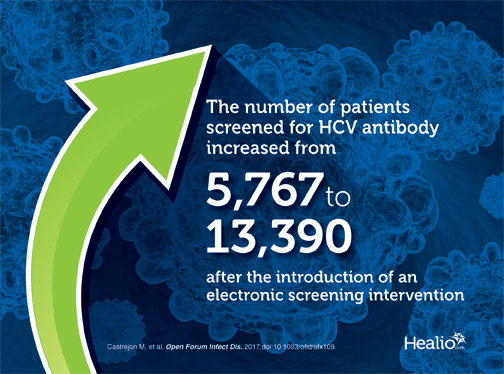Electronic HCV screening intervention improves testing, linkage to care in baby boomers
An electronic health record clinical decision support tool significantly increased hepatitis C virus infection screening, as well as follow-up testing and linkage to care among baby boomers, according to recently published findings.

“The [CDC] and U.S. Preventive Services Task Force recommend a one-time hepatitis C virus screening for adults born between 1945-1965,” Jeffrey D. Klausner, MD, MPH, professor of medicine at the David Geffen School of Medicine, University of California, Los Angeles, and colleagues wrote.
The researchers noted that previous efforts to link patients to care had met with mixed success.
“The biggest gaps are in screening and linkage to care,” the researchers wrote. “It is essential those particular areas be optimized in order to increase downstream treatment rates and improve HCV–related patient outcomes, reduce future health care costs and limit HCV transmission.”
The researchers implemented the electronic health record clinical decision support tool at the UCLA health care system in August 2015. The support tool consisted of a reminder in outpatient electronic health records that patients born between 1945 and 1965 with no history of HCV testing were due for screening. Klausner and colleagues also introduced an HCV care coordinator to facilitate linking patients to care, then compared testing in the year before the intervention with testing in the year following the implementation of the support tool.
Almost 20,000 patients underwent HCV screening during the study period, the researchers reported. Overall screening for HCV antibodies increased from 5,767 to 13,390 (145%) after the support tool was implemented. Furthermore, Klausner and colleagues wrote that screening rose across gender, race and ethnic groups, with older patients showing the largest increase.
After the health care system introduced an HCV care coordinator, follow-up HCV RNA testing for patients who had previously tested positive for HCV antibodies rose from 83% to 95%, the researchers reported. The intervention also demonstrated success in linking patients to care, with 94% receiving care after the tool was implemented.
“There are more people with hepatitis C infection in the United States than HIV infection. Most people with hepatitis C infection do not know it. Left untreated, hepatitis C can lead to liver disease, liver cancer and death,” Klausner told Infectious Disease News. “At UCLA, hepatitis C-related liver disease is one of the most common indications for liver transplant. Hepatitis C is now curable. It is incumbent upon health systems and care providers to find and cure people with hepatitis C. Routine testing and linkage-to-care is one of the best ways to help get those with hepatitis C infection treated.”
– by Andy Polhamus
Disclosure: Klausner reports no relevant financial disclosures. Please see the full study for a list of all other authors’ relevant financial disclosures.

